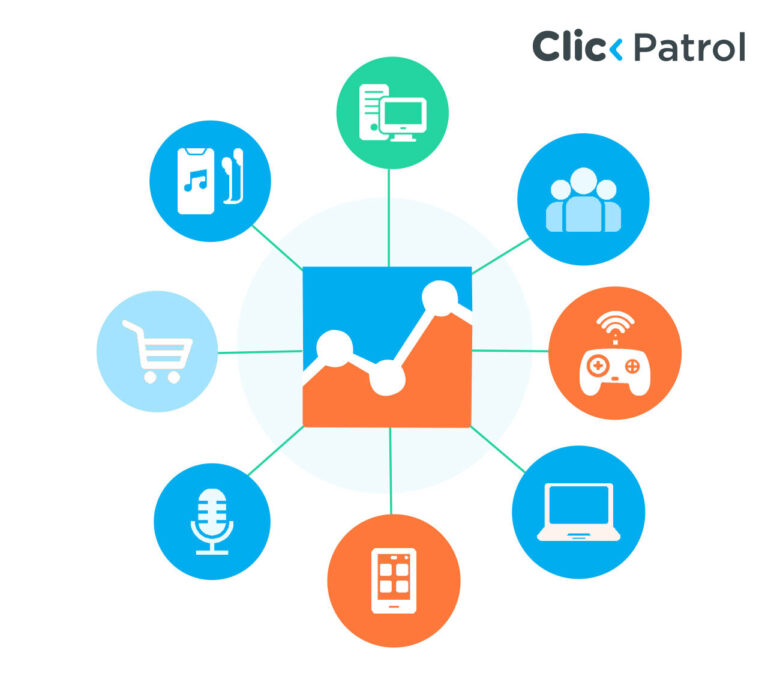
Industry Insights on Click Fraud
Abisola Tanzako | Sep 26, 2024

Table of Contents
Evaluating industry insights on click fraud go a long way in making strategic campaign decisions.
Several industries around the world are being faced with the continuous challenge of click fraud. In 2023, it was estimated that about 14% of all total PPC clicks were fake, which was more prevalent in the digital advertising industry. The financial losses that come with these threatening issues are usually high. In this regard, different reports indicate that for every $5 spent on digital advertising, $1 is spent on click fraud.
Also, click fraud is expected to grow to $172 billion by 2028, and 19% of marketers consider ad fraud and invalid traffic a major issue. To address the issue of click fraud, it is important first to identify the unique effects on different industries and apply proper detection and prevention solutions to ensure the credibility of digital advertising campaigns. This article will help in understanding the effects of click fraud for different sectors and the methods that may be used to identify and avoid such threats to ads and investment.
Industry Insights on click fraud
Click fraud affects multiple industries, each experiencing unique rates, trends, and types:
1. E-commerce industry
Global retail e-commerce sales alone were projected to amount to 5.8 trillion dollars in 2023, which are expected to grow at a rate of 39% in the coming years, projected to reach over 8 trillion dollars in the year 2027. Such growth in the e-commerce industry and the rush in online shopping during Black Friday and Cyber Mondays have led to an influx in invalid clicks. These are usually when internet traffic increases, making it hard to detect fraudulent activities.
The high click fraud rate in the e-commerce industry is attributed to competition and investment in online advertisement expenses. Some of the fraud schemes the e-commerce industry has to deal with are credit card fraud, identity theft, and other multiple fraud strategies like bots and click farms. These are usually specific to product advertisements, drain competitors’ ad budgets, and skew the numbers.
2. Financial industry
The financial services industry is vast and competitive, covering many areas like banking, investing, accounting, and wealth management. It features many high-value keywords that businesses use to stand out in this crowded field. This makes it particularly vulnerable to click fraud. Also, with the growth of digital banking and other online financial products, fraudsters often target ads during times of economic uncertainty or financial crises because there’s more online activity related to financial services.
Approximately 15% of all financial services firms fall into the click fraud rate. This sector poses a higher risk of invalid activities because of the high level of competition, high value of financial keywords, and large amounts spent on advertising. Fraudsters are most attracted to specific keywords associated with loans, credit cards, and investment services.
3. Healthcare industry
The increased digital presence of healthcare services has attracted fraudsters and their invalid activities, particularly for ads related to medical services and products. The COVID-19 pandemic contributed to the healthcare industry’s shift to online healthcare services, increasing the sector’s exposure to click fraud.
The healthcare industry is usually hit by fraudsters, often through healthcare ads, which is common during health crises or seasonal outbreaks when there is a surge in online searches for medical information and services. In 2020 alone, health marketers lost $196 million from invalid clicks; in the US, the biggest market for digital healthcare, it makes up the largest portion of this loss, at $75 million.
To carry out invalid activities, fraudsters use bots, often targeting ads for medical consultations, treatments, and pharmaceuticals, leading to inflated patient costs and reducing health campaign effectiveness. In other cases, these fraudsters may use bots to click on ads for expensive medical treatments or pharmaceuticals, driving up costs for healthcare providers and reducing the visibility of legitimate ads.
4. Real estate industry
The real estate industry is also a target for fraudsters because it has some of the most costly paid search terms, with an average CPC of $2.37 and a high of around $95. This has contributed to the real estate industry seeing an average of 31.25% of fraudulent clicks on paid search and display ads. Such a level of click fraud is driven by the competitive nature of the industry market and the amount of advertising spent on property listings and real estate services.
Additionally, the industry’s shift towards digital property viewings and virtual tours has increased the reliance on online advertising, making it more lucrative and vulnerable to click fraud activities like competitor clicks and automated bots targeting property ads prevalent in this industry. Competitors may click on each other’s ads to deplete advertising budgets and reduce visibility.
Automated bots can be programmed to click on property listings repeatedly, driving up costs and skewing performance metrics. This fraudulent activity can lead to higher costs per click (CPC) and lower return on investment (ROI) for real estate advertisers.
5. Travel industry
The travel industry is another industry faced with click fraud; because of its high transaction amounts, it has become a target for various scams and deceptive activities perpetrated by fraudsters targeting the travel industry. In 2023, travel and leisure was the number two industry globally, with the highest rates of suspected fraud at 36%.
It is particularly vulnerable to click fraud due to the high volume of seasonal promotions, holiday bookings, and the significant advertising spend on travel-related services. Fraudsters take advantage of the travel industry during peak seasons like summer vacations and holidays when there’s a surge in online searches and bookings as there are substantial increases in online searches and bookings.
They target mostly travel ads to deplete advertising budgets and distort performance metrics. The number of online travel agencies and booking platforms has significantly increased exposure to click fraud. Click farms and bots often target ads for flights, hotels, and vacation packages, leading to wasted advertising budgets.
6. Gaming industry
The gaming industry is at high risk regarding click fraud. This is due to the popularity of mobile gaming apps. In 2023, an estimated 3.07 billion gamers were predicted to be engaged in the industry, from 1.9 billion in 2015. This level of growth has made the gaming industry vulnerable to fraudsters, which has become a risk for gamers and the platforms.
Fraudsters use different tactics to infiltrate the gaming industry, such as botnets or click farms to generate clicks on in-app ads, install hijacking or fake installs, and click flooding, driving up advertising costs for game developers and publishers. This type of mobile ad fraud has drained the marketing budgets of companies across the globe, and the mobile gaming industry’s rapid increase in users and traffic makes it all the more appealing for fraudsters looking to steal a cut of the profits.
Detection and prevention
Detecting and preventing click fraud involves a combination of advanced technologies and best practices:
- Detection tools: Employ anti-click fraud solutions like ClickPatrol, in your ads. These tools assist in analyzing and preventing invalid clicks in real-time or while they are being generated.
- Real-time monitoring: Use surveillance mechanisms and auditing techniques to address fraud incidences in the organization.
- Analytics: Clickstream and user activity should be analyzed to detect suspicious behavior that signifies fraudulent actions. This can be done by tracking click-through (CTR) and conversion rates.
- IP blocking: Blocking reoccurring clicks from suspicious IPs is essential, through the ‘black list’ feature, to block IP addresses of sources of fraudulent data. Detecting and preventing click fraud involves avoiding more clicks from them.
- CAPTCHA: Apply CAPTCHA challenges to separate the genuine users from the bots.
Ad networks: Ad networks that you collaborate with should have strict measures against fraud, and you should check on the traffic sources from time to time.
Click fraud concerns across industries.
The incidence of click fraud is currently a major concern across many industries, affecting digital advertising extensively. That is why it is necessary to understand each sector’s specific effects and tendencies and develop adequate detection and prevention measures. These measures help save advertising budgets and provide the proper reliability to the marketing indicators.
Preventive measures and regular monitoring are highly recommended to contain the problems related to click fraud.
FAQs
Q. 1 How does click fraud software work?
Click fraud software uses algorithms and machine learning to filter out fraudulent clicks.
Q. 2 What are the implications of click fraud for my business?
Click fraud has several implications for your business, from increasing advertising costs to generating misleading information for analysis and distorting the measurement of marketing campaigns. It results in wasted money and erroneous results.
Q. 3 What does click fraud benefit?
Many parties may benefit from click fraud, including competitors, fraudsters, ad networks, and publishers, but advertisers are always at the losing end.
Q. 4 Given the above findings, how severe is click fraud?
Click fraud accounts for up to 20% of clicks in paid search campaigns, depending on industry and geographical region.





